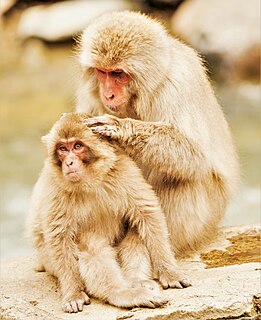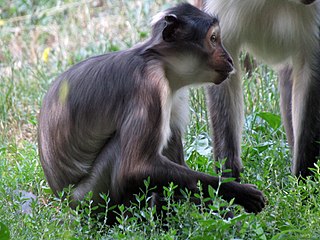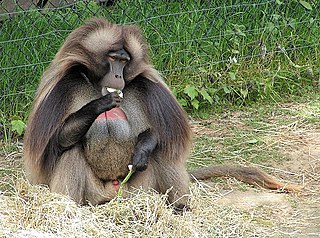
The crab-eating macaque, also known as the long-tailed macaque and referred to as the cynomolgus monkey in laboratories, is a cercopithecine primate native to Southeast Asia. A species of macaque, the crab-eating macaque has a long history alongside humans. The species has been alternately seen as an agricultural pest, a sacred animal, and, more recently, the subject of medical experiments.

The rhesus macaque, colloquially rhesus monkey, is a species of Old World monkey. There are between six and nine recognised subspecies that are split between two groups, the Chinese-derived and the Indian-derived. Generally brown or grey in colour, it is 47–53 cm (19–21 in) in length with a 20.7–22.9 cm (8.1–9.0 in) tail and weighs 5.3–7.7 kg (12–17 lb). It is native to South, Central, and Southeast Asia and has the widest geographic range of all non-human primates, occupying a great diversity of altitudes and a great variety of habitats, from grasslands to arid and forested areas, but also close to human settlements. Feral colonies are found in the United States, thought to be either released by humans or escapees after hurricanes destroyed zoo and wildlife park facilities.

The Barbary macaque, also known as Barbary ape or magot, is a macaque species native to the Atlas Mountains of Algeria and Morocco, along with a small introduced population in Gibraltar.

The Japanese macaque, also known as the snow monkey, is a terrestrial Old World monkey species that is native to Japan. Colloquially, they are referred to as "snow monkeys" because some live in areas where snow covers the ground for months each year – no other non-human primate lives further north, nor in a colder climate. Individuals have brownish grey fur, pinkish-red faces, and short tails. Two subspecies are known.

The vervet monkey, or simply vervet, is an Old World monkey of the family Cercopithecidae native to Africa. The term "vervet" is also used to refer to all the members of the genus Chlorocebus. The five distinct subspecies can be found mostly throughout Southern Africa, as well as some of the eastern countries. Vervets were introduced to Florida, St. Kitts and Nevis, Barbados, and Cape Verde. These mostly herbivorous monkeys have black faces and grey body hair color, ranging in body length from about 40 cm (16 in) for females, to about 50 cm (20 in) for males.

The pygmy marmoset, genus Cebuella, is a small genus of New World monkey native to rainforests of the western Amazon Basin in South America. It is notable for being the smallest monkey and one of the smallest primates in the world, at just over 100 grams (3.5 oz). It is generally found in evergreen and river-edge forests and is a gum-feeding specialist, or a gummivore.

The chacma baboon, also known as the Cape baboon, is, like all other baboons, from the Old World monkey family. It is one of the largest of all monkeys. Located primarily in southern Africa, the chacma baboon has a wide variety of social behaviours, including a dominance hierarchy, collective foraging, adoption of young by females, and friendship pairings. These behaviors form parts of a complex evolutionary ecology. In general, the species is not threatened, but human population pressure has increased contact between humans and baboons. Hunting, trapping, and accidents kill or remove many baboons from the wild, thereby reducing baboon numbers and disrupting their social structure.

The cotton-top tamarin is a small New World monkey weighing less than 0.5 kg (1.1 lb). This New World monkey can live up to 24 years, but most of them die by 13 years. One of the smallest primates, the cotton-top tamarin is easily recognized by the long, white sagittal crest extending from its forehead to its shoulders. The species is found in tropical forest edges and secondary forests in northwestern Colombia, where it is arboreal and diurnal. Its diet includes insects and plant exudates, and it is an important seed disperser in the tropical ecosystem.
Parent–offspring conflict (POC) is an expression coined in 1974 by Robert Trivers. It is used to describe the evolutionary conflict arising from differences in optimal parental investment (PI) in an offspring from the standpoint of the parent and the offspring. PI is any investment by the parent in an individual offspring that decreases the parent's ability to invest in other offspring, while the selected offspring's chance of surviving increases.

The sooty mangabey is an Old World monkey found in forests from Senegal in a margin along the coast down to the Ivory Coast.

The wedge-capped capuchin or Guiananweeper capuchin is a capuchin monkey from South America. It is found in northern Brazil, Guyana and Venezuela. The genus Cebus is divided into several different species. However, taxonomists argue over the specific divisions within the genus, which are uncertain and controversial. Cebus olivaceus is known to dwell in tall, primary forest and travel over long distances during the day.

In animals, infanticide involves the killing of young offspring by a mature animal of the same species, and is studied in zoology, specifically in the field of ethology. Ovicide is the analogous destruction of eggs. The practice has been observed in many species throughout the animal kingdom, especially primates but including microscopic rotifers, insects, fish, amphibians, birds and mammals. Infanticide can be practiced by both males and females.
Allomothering, allomaternal infant care/handling, or non-maternal infant care/handling is performed by any group member other than the mother. Alloparental care is provided by group members other than the genetic father or the mother and thus is distinguished from parental care. Both are widespread phenomena among social insects, birds and mammals.

One-male groups are a type of social organization where one male interacts with a group of females and their immature offspring. Offspring of both sexes are evicted from the group upon reaching puberty. It can be seen in many species of primates, including the gelada baboon, the patas monkey, savanna baboon, sun-tailed monkey, golden snub-nosed monkey, and the hamadryas baboon. There are costs and benefits for individuals living in one-male groups. As well, individuals within one-male groups can interact with each other just like individuals can interact with those from different one-male groups.
Female copulatory vocalizations, also called female copulation calls or coital vocalizations, are produced by female primates, including human females, and female non-primates. Copulatory vocalizations usually occur during copulation and are hence related to sexual activity. Vocalizations that occur before intercourse, for the purpose of attracting mates, are known as mating calls.

A gecker is a vocalization most often associated with infant primates. It is defined as a loud and distinct vocalization, which consists of a broken staccato noise. In 1965, Irven DeVore of the Center for Advanced Study in the Behavioral Sciences described geckering as a "single sharp yak sound", which may be repeated. It has also been characterized as "cackling." It is common in to all types of macaques, geckering is also associated with fearful jackals and mongooses. Patas monkeys have also been observed to gecker. In macaques, bickering is associated with spastic jerking of the body. Geckers are also commonly displayed in combination with grimaces.
In biology, paternal care is parental investment provided by a male to his own offspring. It is a complex social behaviour in vertebrates associated with animal mating systems, life history traits, and ecology. Paternal care may be provided in concert with the mother or, more rarely, by the male alone.
Endocrinology of parenting has been the subject of considerable study with focus both on human females and males and on females and males of other mammalian species. Parenting as an adaptive problem in mammals involves specific endocrine signals that were naturally selected to respond to infant cues and environmental inputs. Infants across species produce a number of cues to inform caregivers of their needs. These include visual cues, like facial characteristics, or in some species smiling, auditory cues, such as vocalizations, olfactory cues, and tactile stimulation. A commonly mentioned hormone in parenting is oxytocin, however many other hormones relay key information that results in variations in behavior. These include estrogen, progesterone, prolactin, cortisol, and testosterone. While hormones are not necessary for the expression of maternal behavior, they may influence it.
Infanticide in non-human primates occurs when an individual kills its own or another individual's dependent young. Five hypotheses have been proposed to explain infanticide in non-human primates: exploitation, resource competition, parental manipulation, sexual selection, and social pathology.

The Selangor silvered langur is a species of leaf monkey found on the west coast of Peninsular Malaysia. It had been previously considered a form of silvery lutung. Roos and colleagues elevated this population to a subspecies level, Trachypithecus cristatus selangorensis, in 2008. It has since come to be regarded by primatologists as a separate species, Trachypithecus selangorensis.















